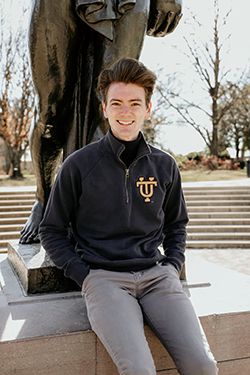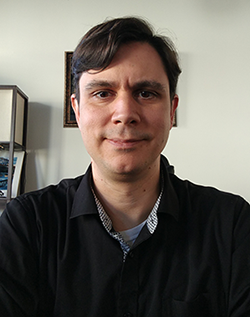A Reboot for Modern Astronomy
April 22, 2022
Lucas McClure’s scientific path has taken him across Tennessee to Route 66, by way of the asteroid belt.
It all started in Martin, Tennessee, where McClure grew up. A high school geology class sparked an interest in planetary science and inspired him to look at home-state colleges with astronomy programs. That’s how he met Sean Lindsay and Josh Emery and decided to attend UT. Five years later, he’s earned a bachelor’s degree, moved across the country, started a PhD, and published his first papers. Those publications share an updated methodology for analyzing objects present at the solar system’s debut. They’re also proof of the difference good mentors can make.

Lucas McClure (by Hannah Roberson)

Sean Lindsay
Astronomy research has a few hurdles, the most obvious being that it’s difficult to get to the stuff you want to study. Yet there are earthly clues that enterprising researchers can use to form a bigger picture.
"Astronomy is a field without a laboratory that’s nearby," McClure explained. "One of the rare cases where it’s not really far away is meteorites and meteorite analysis."
To back up, let’s start with asteroids, the leftovers of planetary formation. Rocky and small (astronomically speaking), most reside in a belt that orbits our sun. Asteroids are like party guests who hold on to souvenirs from the big event. In this case those keepsakes are materials that haven’t changed since the solar system was born. When a piece breaks off an asteroid, it’s called a meteoroid. Meteoroids that fall to Earth are meteorites. McClure explained that over the past three decades astronomers have studied connections between these leftovers of the leftovers, so to speak, and asteroids themselves.
"They’ve found that there’s a substantial link between certain types of meteorites and certain types of asteroids," he said. "These asteroids are rocky and metallic—hunks of space debris—and so by understanding the meteorites that are right here on the Earth we can understand, by proxy, the asteroids. We want to compare (them) to understand their connection, and what that means about the formation and evolution of the solar system."
Asteroids are classified by how they reflect light. The range of that reflectivity at different wavelengths is a spectrum; the shape of that spectrum is an asteroid’s "fingerprint." Siliceous asteroids (S-type) get their name from their stony, mineralized composition. They also share spectral features with the most common type of meteorite: the ordinary chondrites (OCs), primitive stony objects found on Earth. McClure explained that both have electron absorptions at 1- and 2- micron wavelength regions, typically denoted as band 1 and 2. When astronomers plotted these parameters they found that ordinary chondrites curve in a shape resembling a boot.
"It’s a really versatile region for understanding the connections between asteroids and meteorites, but it’s been used since 1993 and it hasn’t been updated since," he said.
Lindsay, a senior lecturer and research assistant professor, said the area was "being treated like a fixed dartboard," though he noticed in his own research that a lot of asteroids were falling outside the "boot" region. That meant calculations assessing the mineralogy of those objects wouldn’t be completely dependable.
"We can only apply those equations if we are certain that the asteroid is OC-like," he said. "You don’t want to use those equations if they’re not. So (for) every miss on our OC-boot dartboard, we don’t know if we can reliably trust the mineralogy we are getting."
The old model also excludes a growing number of band parameter analysis techniques, so people using different methods were getting similar but different results.
To freshen up the framework, Lindsay and McClure used a software routine Lindsay developed called Spectral Analysis Routine for Asteroids (SARA), which allowed for targeted band parameter analysis. With this self-consistent methodology, they were able to include more asteroids, confident those objects were similar to the ordinary chondrites and the mineralogy calculations would be more accurate.
"(This) is the kind of information that we need to really learn about the origins and evolution of the solar system," Lindsay said.
The OC-boot research was the basis of McClure’s senior thesis. The results were recently published in the journal Icarus, split in two papers. They’re his first publications, and he’s the first author on both, sharing the byline with Lindsay. It’s a milestone on his scientific journey, which began when he reached out to Lindsay and Emery before he ever enrolled in college.
"I’ve been interested in planetary science since high school," McClure said. "I’ve been in contact with Sean at least since (then)."
Lindsay, a UT Physics graduate, returned to the department in 2015 to teach, conduct research, and coordinate the astronomy program. Emery, now with Northern Arizona University (NAU), was then a member of the UT Earth and Planetary Sciences faculty. McClure said he wanted to know “what it takes to be a planetary scientist” and Lindsay and Emery (research colleagues) were happy to answer his questions. He started UT in August 2016 and joined Emery’s research group the following January. That’s when he began working with Lindsay.
"Sean’s really good at being a mentor," McClure said.
He asked Lindsay to advise him on a senior thesis, taking advantage of the Research and Independent Study and Thesis courses to do the work.
"From my perspective," Lindsay said, "it was a class that he was taking, so I really wanted to dedicate some time and effort to put together a program that walked him through what it meant to be a scientist. I think the umbrella of having that in a credit framework really helped. Any student looking to get research experience and credit that actually counts toward their graduation can do so."
McClure dove right in, gaining experience in coding, literature review, and scientific writing.
"It gave me a really full research experience," he said. "It also helped me understand the smaller details of finding and using necessary data, conveying the results, and actually understanding what your results mean. The whole scientific process was teased out for my thesis project."
"Any student looking to get research experience and credit that actually counts toward their graduation can do so."
After earning a bachelor’s degree in December 2020 with a major in physics and a minor in geology, he headed to NAU for graduate school. He’s in Emery’s research group and still learning about the spectral information of asteroids.
Life in Arizona has turned out to be an added bonus. McClure lives right off the famed Route 66, just down the road from the Grand Canyon. He’d never been west of St. Louis and said Flagstaff was a good choice, with beautiful scenery and geological elements that appeal to the meteorite analyst in him. Eventually though, he’d like to head back home.
"I do think I want to go back to the Southeast," he said. "That’s where I grew up (and) where all my family is."
He said he’d be happy working in a museum, planetarium, or maybe teaching at the college level. Whatever he chooses, he said he wants to make a contribution, and, in the mold of his mentors, "maybe change a kid’s life."